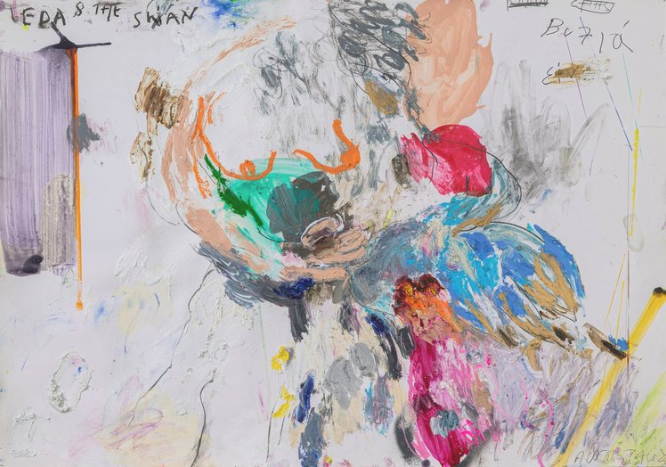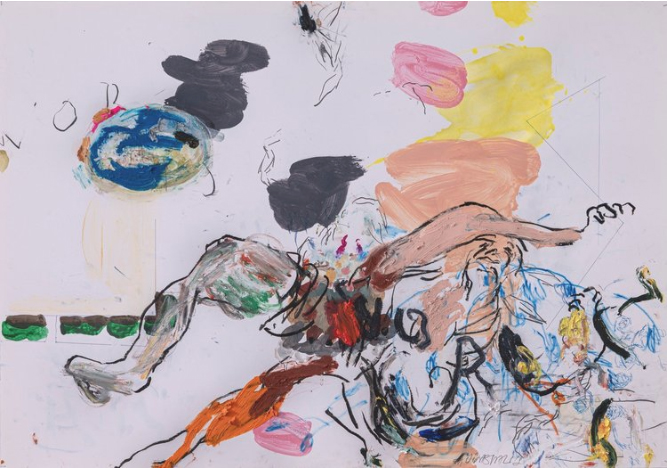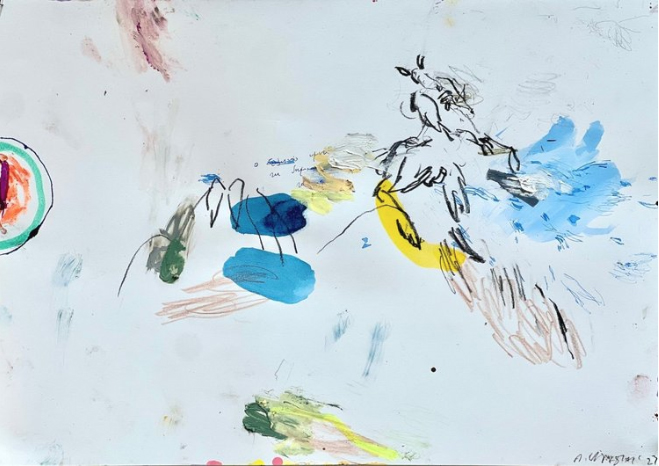by: Dr. Thalia Vrachopoulos
With colorful, gestural abstract forms, exuberantly captured through diverse emotions, conceptual word-games and expressive brushstrokes, Ariadne Vitastali’s paintings are a unique evolution of the visual tradition of the Northwest School Abstraction. Full of spontaneous markings of color tones with melodic lines as seen in Abstraction Lyrique, or automatist subconscious gestures, similar to Action Painting and finally gentle calligraphic movements reminiscent of the techniques of the American painter Mark Tobey, her neo-expressionist images can be formally compared to the radical experiments of the Dutch-American painter Willem de Kooning.

Willem de Kooning believed about his abstract painting that «It’s really absurd to make an image, like a human image, with paint, today, when you think about it…. But then all of a sudden it was even more absurd not to do it. … It [painting Woman, Ι] did one thing for me: it eliminated composition, arrangement, relationships, light – I put it in the center of the canvas because there was no reason to put it a bit on the side. So, I thought I might as well stick to the idea that it’s got two eyes, a nose and mouth and neck.». Artist statements can sometimes be misleading in that, out of a desire to control their public image artists sometimes overstate or exaggerate their statements.
Thus, one can safely assume that de Kooning’s work and by extension Vitastali’s were very meticulously planned, whilst both artists precisely considered the formal aspects of their compositions before their artistic execution in order to create a paradoxical sort of accidental perfection. Morphologically this can be confirmed by a careful examination of their artworks. De Kooning saved and cut-out various images of women from popular presses, something that demonstrates forethought and planning, while their placement also illustrates pre-planning and strategy as also Vitastali’s carefully chosen compositional designs. In fact, Vitastali’s compositions are often diagonally situated causing the eye to be active according to Expressionist principles.

Although Vitastali’s recent works are abstract, her oeuvre straddles the categories between abstract and abstracted, in that her non-relational images maintain some recognizable motifs. As seen in several 2022-2023 Untitled paintings, the artist uses abstracted modes in order to treat subjects with a feminist bent while depicting mythological heroines. One such painting is Untitled III, 2023 -wherein a figure is seen tumbling backwards into a chasm-that can be read in terms of the Demeter legend. When Persephone, her daughter was abducted by Hades the God of the underworld, Demeter went to Hades to seek her out, and her absence caused a famine on earth. To Vitastali’s predecessors -the American Abstract Expressionists- myth was also important informing the work of William Baziotes, Jackson Pollock, Willem de Kooning and Mark Rothko. These artists including Vitastali, used a semi-representational or abstracted style in their early careers later becoming increasingly abstract.
The term “abstract” and its varying degrees, carries a whole range of associations and descriptions. German-born American artist and museum founder, Hilla von Rebay, used the term gegenstandlos (to describe her abstract painting), which American artists later mistranslated as “object less painting.” Rebay who associated her visual production with “pure” music, like Kandinsky, believed that art should be externalized from the inner cosmos of the artist and not from a simple abstraction of external nature. This particular idea paradoxically already existed in the Christian aesthetics of the Middle Ages and Scholasticism and was quite widespread until the Renaissance and Mannerism. The artist-craftsman was not supposed to simply copy, or mimic the material world, but instead to reflect within his inner psyche, the divine “ideas” that constitute a higher dimension than world of phenomena or changing space-time.
Erwin Panofsky in his book Idea: A Concept in Art Theory, specifically wrote that the work of art “far from being merely derived from the creations of nature and transferred to the work of art by a simple act of copying, lives in the mind of the artist himself and is directly translated by him into matter.”Similarly, modern abstract painting rejected the Platonic concept of art as “mimesis” and attempted to return to a more primal state of art, i.e. to a non-representational art, where the artist expresses an inner and intuitive world-picture (Weltbild) of the external reality -or as Rebay meant the word gegenstandlos as “subjective”. The art theorist Wilhelm Worringer also believed that primitive art is par excellence a “pure, geometric and abstract” art, where the subject unconsciously tried to escape the eternal flux of the varying phenomena of the outer world.

As Kant believed, despite all the avant-garde’s radical convictions about an abstract art of the future, abstract art essentially managed to return to a primordial side of pictorial art, where the inner world of the human psyche with all its violent permutations is no longer separated from an inaccessible rift in the external world. But instead, through abstract art (as well as music), the numinous phantasmagorias of the soul are translated externally without the need to appropriate a material form, or an external image. They should instead be expressed through a kind of formal “formlessness”, in which they visually diffuse without the metaphorical clothing of a phenomenal world. Thus, the Kantian separation of the thing-in-itself (i.e. the noumenon) and ephemeral phenomena no longer exists and the abstract artist as a new kind of shaman, or magician directly externalizes his immaterial and aniconic thoughts-feelings into objective reality, restoring thus a long-gone universal communication for humanity, despite linguistic, ethnic and cultural differences among civilizations. The imaginal (and also formless) medium of the abstract artist here manifests itself as a universal language of specific moods (Stimmungen) or even archetypical experiences, which every human, as Carl Jung strongly affirmed, everywhere in the globe subliminally shares.
Likewise, Vitastali’s complex, yet simultaneously time-minimal works externalize the boundary between abstraction and figurative painting. Between the dreamlike masses of pure color, anthropomorphic figures and illusory forms can be discerned, which blend together within the streams of discrete colorfulness. Thus, different fragments of lost forms are revived in an elaborate, but simple mosaic of lively hues, where the unconscious tendencies of an inner world are imprinted like living spots on the white paper, while morphic modulations and color-form sketches recreate the subliminal tones of a lyrical locus of abstract images. Her present paintings are abstracted, representing as such an engagement with her earlier mode of working, which rigorously marks her maturity as an artist.
As Ariadni Vitastali writes in her statement about her new works “the painting elements of form, color, gesture, line, as also fragments of phrases, or simply words, define the worked surface as abstract elements, insinuating a glimpse view of a momentary and subjective reality”.
